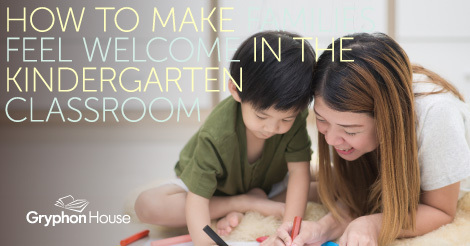How to Make Families Feel Welcome in the Kindergarten Classroom
December 2nd, 2016 | 4 min. read
By Anna Wilmoth


The kindergarten classroom has many parts. There are centers that must be set up, decorations to go on the wall, desks for sitting at, pencils and paper for writing, and of course the teacher who puts it all together. However, though the teacher’s importance to the classroom is never in question, there is another group of adults who critically impact early childhood education: parents. Parents and guardians shape their children’s learning and behavior just as much as teachers. It is therefore very important to make parents a part of their children’s academic learning process by creating an inclusive classroom.
An inclusive classroom focuses on making sure the families of students feel welcome and included in their child’s education. While many kindergarten teacher resources talk about how to present academic ideas to children, they often gloss over the need for curriculum communication between teacher and guardian. Families want to know what their child is being taught and how the classroom is being run, but certain factors can get in the way of that communication. Thankfully, there are some resources available. The Welcoming Classroom, one of a few teacher resource books that focus on family inclusivity in the classroom, contains tips and bits of advice on how you as an educator can bridge that gap.
Understanding Families
The first and most important step to inclusivity is understanding the people you are striving to include—in this case, the families. Whether we recognize it or not, most of us have a preconceived idea of what the average family looks like. This image may vary from person to person, but it is used by its respective educator as a template for interacting with students’ families. While most professional educators make a conscious effort to look past biases towards race, gender, or marital status of guardians, there can still be misunderstandings and biases based on economic situation and culture.
In The Welcoming Classroom, author Johnna Earnst uses the example of an immigrant family whose parents speak little English and work two jobs each, since none of the jobs earn a living wage on their own. This family could be viewed one of two ways: as two hardworking parents with developing literacy skills struggling to provide for their children, or as two non-English speakers working low-wage jobs. Neither of these descriptions is incorrect, but the first one attaches emotional background to the circumstances and therefore provides a better template for empathy and cooperation between educator and parent.
Another thing to take into account is cultural differences. Customs one educator may view as normal—i.e. a handshake upon meeting—may be seen as rude or awkward by a guardian of a different background. This applies to attitudes towards teaching and childrearing as well. If, for example, you are teaching a student whose family comes from a culture in which it is unusual to speak outside the home, your presenting the child’s silence as an issue will be confusing to the guardians who expect her to be quiet. Meanwhile, some families may consider themselves a big part of the education process while others view education as the teacher’s sole responsibility. There is a great amount of diversity within any classroom, so time should be taken with each family to learn what parents expect from the teacher.
Engaging with Families
Once communication is established between teachers and guardians, the next thing to do is find ways to engage parents with the learning process. This can be accomplished in a variety of ways. One of the most basic is keeping parents up to date with what you are doing each week in the classroom. This often extends beyond a simple newsletter or copy of the lesson plan; talking directly to the parent about how this or that activity will help their child gives the parent the opportunity to ask questions or make suggestions. Doing this during pick-up or drop-off during the day or making individual phone calls can provide this means of communication.
Of course, in order to exchange ideas about how best to run the classroom, parents and educators must be able to talk to one another. Sometimes, special accommodations must be made. For example, if the guardians of a child speak little English but sincerely want to discuss the child’s progress and curriculum with the teacher, a translator may need to be used during a conference. Another family may have only one parent who works long, irregular hours, making scheduling a face to face conference very difficult. In that case, the educator could suggest an over the phone conference that could be done from the parent’s workplace. Extraneous resources and accommodations should be provided by the school.
Once those conferences are achieved, it is important to respond to parents’ concerns quickly and appropriately. Sometimes, teachers can get lost in the terminology of the field when explaining a lesson plan or special program for a child, which can lead to misunderstanding and tension between them and the parents. Parents of different cultural backgrounds may also feel a certain way about how things are being taught. In these cases, take the time to explain thoroughly why the curriculum contains what it does and how each lesson contributes to the development of the child. When a guardian’s concerns are taken seriously, they will be more willing to trust the teacher and come back if they encounter another problem.
Incorporating Families
One very fun way to include families is to actively invite them into the classroom! Buy setting up career days or “bring your parent to school” days, you both give parents a role in the students’ learning process and provide an opportunity for guardians to see exactly what goes on in their child’s classroom. This actively engages families, builds trust, and creates a much more welcoming environment.
Direct family engagement isn’t reserved to classroom appearances either. Making crafts for family members, bringing photographs from home, and doing activities that facilitate discussion about families bridge the gap between the school and home environment, which can make young children feel more comfortable in the classroom. Connecting the two environments will also make certain skills, like sharing and communicating, stick in the children’s minds and become applicable to multiple settings.
Families are vitally important to the education of young children. They provide groundwork for development and are the primary influence over a child’s early years. Therefore, it is important parent and educators are able to work together in an inclusive learning environment that will facilitate growth and communication, for both students and parents.
Author(s)Johnna Darragh Ernst, PhD
Marketer. Publisher. Reporter. Educator. Mother. Runner. Explorer. Anna served as director of marketing for Gryphon House from Oct 2014 - May 2017.
Topics: